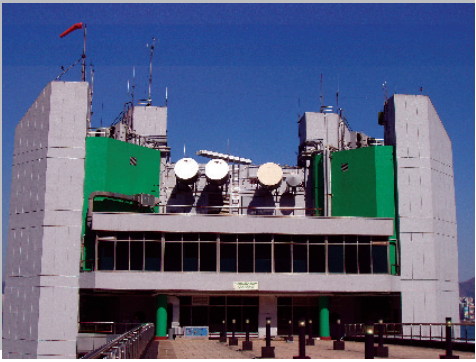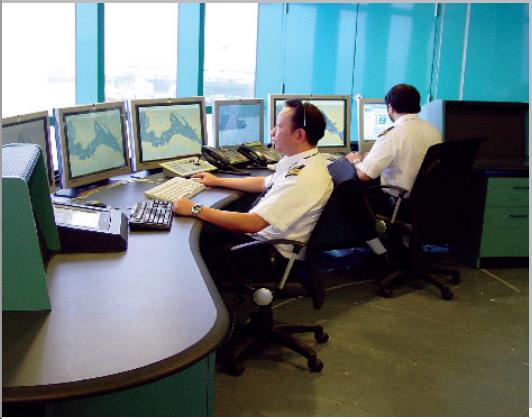Current operation of the Vessel Traffic Centre and Vessel Traffic Services (VTS)
It is a legislative requirement that vessels shall notify the Marine Department not less than 24 hours in advance of their arrival in the waters of Hong Kong. Before entering Hong Kong, vessels should communicate with the Vessel Traffic Centre and provide any necessary updates. The Hong Kong Vessel Traffic Services cover all navigable waters within Hong Kong boundaries. All ocean-going vessels and river-trade vessels over 1,000 gross tonnage are required to participate.
For effective monitoring and regulation of the heavy traffic, the waters of Hong Kong are divided into three sectors, namely the Eastern Approach, the Western Approach and the Harbour. The first contact between a vessel and the Vessel Traffic Centre is by very high frequency (VHF) radio. The radar information of vessels, together with data from the VHF Direction Finder, will be sent to the Vessel Traffic Centre in order to chart the course and position of the vessels. On the other hand, vessels are required to report their location to the Vessel Traffic Centre at the calling-in points. By continuous interaction and exchange of marine traffic and related information between the Vessel Traffic Centre and vessels, control of marine traffic and safety in port are enhanced.
Kwai Chung Marine Traffic Control Station (KCCS)
The Kwai Tsing Container Terminals underwent continuous development over time. As a result, the number of visiting vessels and the importance of timeliness increased. Before 1997, the Kwai Chung area was beyond the reach of the Vessel Traffic Centre as it was located far away from the Centre. To monitor port traffic in the Kwai Chung area more effectively, the Vessel Traffic Centre established the Kwai Chung Marine Traffic Control Station (KCCS). The station helped to enhance co-operation between pilots and terminal operators so that delays of vessels could be avoided.
After 2004, as the Kwai Tsing terminals started handling river-trade containers, river-trade vessels were able to ship goods directly to the terminals and unload them there, doing away with the cost of land transportation. As a result, the number of river-trade vessels in the Kwai Chung area increased. The role of the KCCS then shifted to one of co-ordinating traffic between ocean-going vessels and river-trade vessels guided by pilots so as to ensure their smooth entry into and exit from the Kwai Chung port.
The Second Generation VTS System
In order to cope with the increasing volume of marine traffic resulting from the rapid development of the port, the VTS System was upgraded in 2002. The second generation of the VTS System provides a more efficient means of facilitating daily operations. For example, closed circuit television (CCTV) cameras with light intensifiers are installed at radar stations to allow visual monitoring of marine traffic; the automatic identification system (AIS) is integrated into the VTS System to receive data on identification and location transmitted by vessels installed with AIS transponders. The AIS system, with six base stations, provides full coverage of the Hong Kong waters. Integration of AIS with the VTS System enables the automatic identification of vessels and enhances the reliability of vessel tracking. In addition to providing identity and position information, the AIS offers the additional function of transmitting text messages, such as those on visibility information, to vessels that are equipped with AIS.
A replacement of the second generation VTS will be commissioned in 2016. The new system will adopt the most advanced technology and comply with the latest international requirements prescribed by the International Association of Marine Aids to Navigation and Lighthouse Authorities (IALA) and the International Maritime Organization (IMO).
Marine Department Training Centre
Established in December 2000, the Marine Department Training Centre is located at the Government Dockyard on Stonecutters Island. It is dedicated to providing professional training to officers of the Marine Department and enhancing the safety awareness of the marine community. The objective of the centre is to deliver quality training services so as to equip officers with the knowledge necessary for discharging duties. The centre is headed by a Senior Marine Officer. All trainers are ex-shipmasters or ex-deck officers with vast experience in the department in various capacities.
In addition to traditional lecture rooms fitted with full audio-visual teaching aids, a variety of computer-based simulation equipment has been installed in the Training Centre. Such equipment includes the Full Mission Ship Simulator, the Global Maritime Distress and Safety System (GMDSS) Simulator, and the VTS Simulator. The Full Mission Ship Simulator consists of a 210-degree horizontal field of view projected through seven channels and a mock-up bridge with fully equipped control console. It provides training in navigation and familiarises officers with bridge operations through tailored simulation exercises. The GMDSS Simulator comprises an instructor station and six trainee workplaces. Practice sessions are conducted to simulate different situations including distress and emergency. The VTS Simulator is designed on the basis of model courses developed by IALA. The simulator comprises an instructor console and two trainee workplaces. The instructor can create various scenarios to simulate normal traffic conditions as well as certain emergency situations to meet different training objectives.
Ma Wan Marine Traffic Control Station and Ma Wan Backup Centre
Owing to the development of Shekou Port at Shenzhen, there was an increase in the number of vessels travelling through Ma Wan. In order to facilitate vessel traffic, the Ma Wan Marine Traffic Control Station was established in 1995 to deal with any possible traffic congestion, with a dedicated government patrol launch for regulating traffic. When the second generation VTS System was launched, the Ma Wan Marine Traffic Control Station went through re-organisation and was relocated to the Vessel Traffic Centre.
In 2010, the original site of the Ma Wan Marine Traffic Control Station was re-developed to house the Ma Wan Backup Centre. The centre was established to maintain emergency backup facilities for the Vessel Traffic Centre and the Maritime Rescue Co-ordination Centre.




